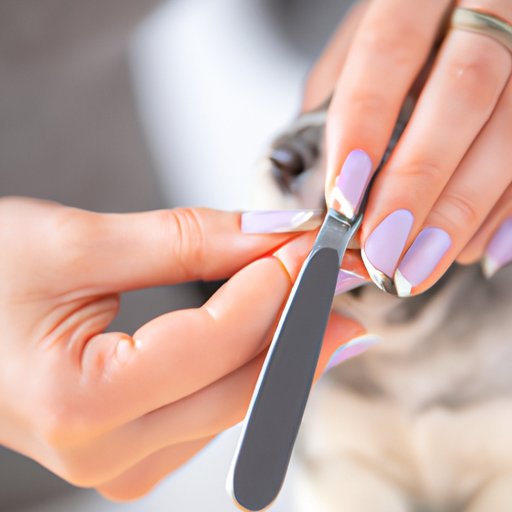Introduction
As a dog owner, one of the important things to remember is keeping your dog’s paws healthy and happy. One way to do this is by trimming your dog’s nails. Why is it important to trim your dog’s nails, you may ask? Overgrown nails can cause various health problems, discomfort, and even injuries. In this article, we will discuss how to properly cut your dog’s nails and go over different benefits of doing so.
Step-by-Step Guide to Cutting Dog’s Nails
Before starting, it is important to gather all necessary equipment such as a good quality dog nail clipper or grinder, styptic powder, and treats as rewards. Once you have everything you need, follow these simple steps:
1. Get your dog in a comfortable and relaxed position. You can either sit on the floor with your dog in your lap or have them sit or lie down on a non-slip surface.
2. Take one of your dog’s paw and hold it gently but firmly.
3. Using proper dog nail clippers, trim the nail at a 45-degree angle, starting from the bottom and going up to the top. Avoid cutting too close to the quick, which is the pink area in the nail that contains blood vessels and nerves.
4. If you accidentally cut the quick, apply styptic powder to stop the bleeding.
5. Repeat the process for each nail and don’t forget to reward your dog with a treat after each successful trimming session.
Identifying the Quick
The quick can be difficult to identify in some dogs, especially those with dark or black nails. However, it is important to try to identify it to avoid hurting your dog. One way to do this is by looking at the underside of your dog’s nail. You can try to identify where the pink is starting and avoid cutting through that area.
Tips for Proper Trimming
Cutting your dog’s nails can be a daunting task, especially if you are a new pet owner. Here are some tips to ensure proper trimming:
– Cut in small increments to avoid cutting the quick
– Use treats as rewards to keep your dog calm and relaxed
– Use sharp nail clippers to avoid splitting the nail
– Trim your dog’s nails regularly to ensure proper length
Health Benefits of Trimming Dog’s Nails
Trimming your dog’s nails regularly offers multiple health benefits. These include:
– Reducing the risk of infection: Overgrown nails can trap dirt and bacteria, leading to infections if not properly cleaned.
– Preventing painful ingrown nails: Overgrown nails can grow into your dog’s paw pads, causing pain and inflammation.
– Reducing the risk of injury to your dog’s paw pads: Overgrown nails can change the way your dog walks, leading to injuries such as strains and sprains.
Common Mistakes
While trimming your dog’s nails, it is important to avoid common mistakes that can cause harm. Here are some mistakes to avoid:
– Cutting too close to the quick: This can cause bleeding and pain in your dog.
– Not using sharp nail clippers: Using dull clippers can cause splitting and tearing of the nail.
– Being too rough with your dog: This can cause your dog to become fearful or anxious, making the whole experience stressful for both you and your pet.
Alternative Methods
If you find the traditional method of trimming your dog’s nails challenging or uncomfortable for both you and your dog, there are alternative methods you can try. These include:
– Using a Dremel tool: This is a motorized tool that grinds down the nail instead of clipping it. It can be a more comfortable and less stressful option for your pet.
– Seeking out a professional groomer or veterinary technician: If you are unsure how to trim your dog’s nails or you prefer to let a trained professional handle it, you can take your dog to a groomer or veterinary technician.
– Pros and cons of each method: While the traditional method of trimming nails is quicker and more affordable, alternative methods offer a more comfortable and less stressful experience. It is important to find what works best for you and your dog.
Breed-Specific Advice
Different breeds of dogs have different nail lengths and levels of sensitivity. Here are some breed-specific pieces of advice:
– For dogs with dew claws: Dew claws are located higher up on the leg and don’t touch the ground when the dog walks. However, they still need to be trimmed regularly to prevent them from growing too long.
– For dogs with white nails: In white nails, the quick is easier to identify as the pink part is more visible.
– For dogs with black or dark nails: Use a flashlight to help identify the quick, or simply trim small increments at a time.
Conclusion
Trimming your dog’s nails may seem like a daunting task, but it is an essential part of keeping your pet healthy and happy. Regular trimming can prevent various health problems, reduce discomfort and injuries. By using this step-by-step guide, you can trim your dog’s nails safely and effectively. Remember to be patient, reward your dog, and avoid common mistakes. With practice, you’ll become an expert at keeping your furry friend’s paws healthy and happy.
